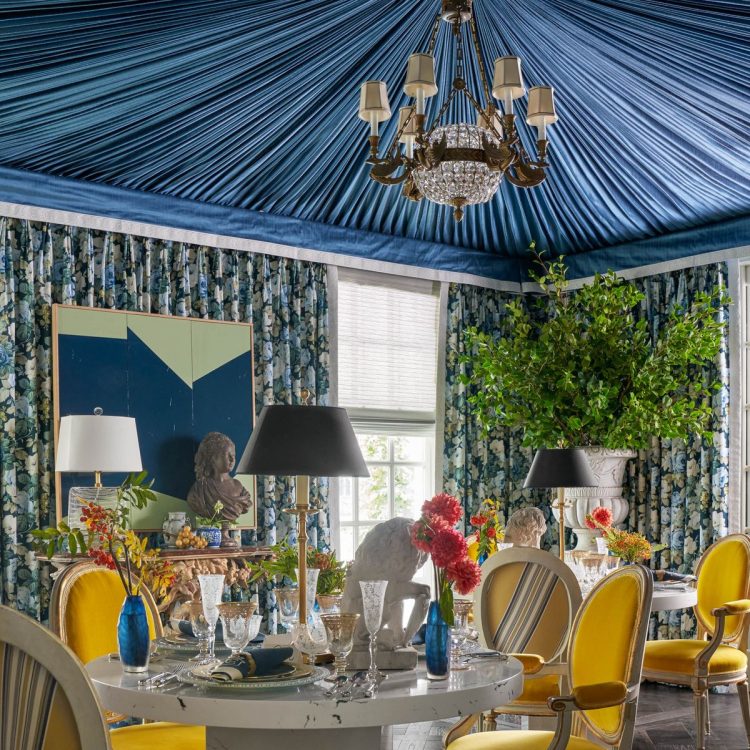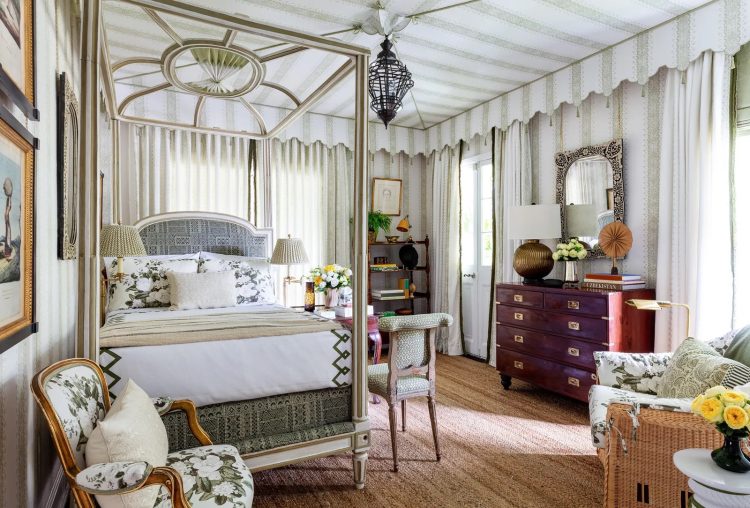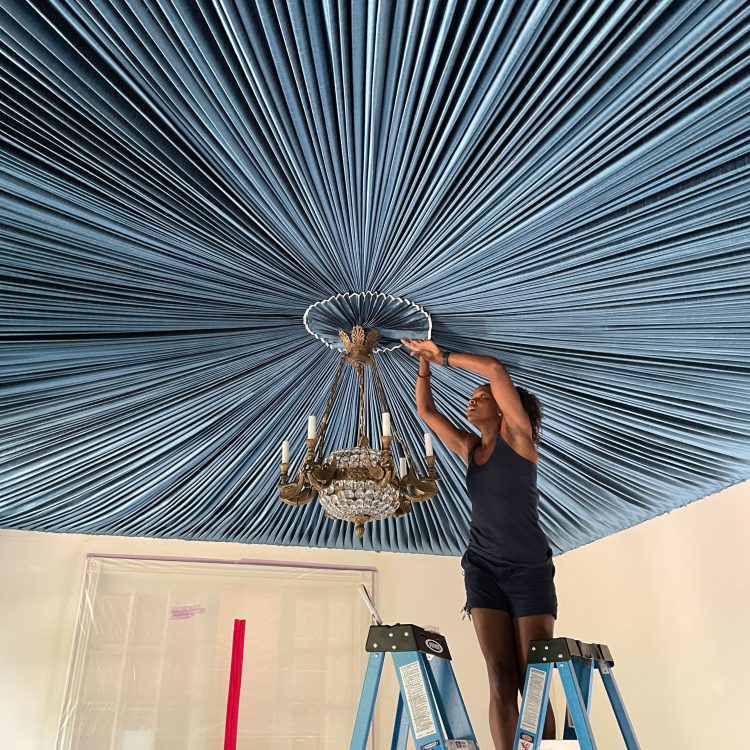Welcome to Artisan Spotlight, a column where we highlight Members’ favorite crafts and tradespeople, showing the work they bring to finished projects as well as the ways they view craftsmanship in a digitized world.

A dining room by DLN Member Corey Damen Jenkins with a tented ceiling by French Finish. Photo: Nathan Schroeder.
If you’ve ever opened a design magazine or attended a major showhouse, chances are you’ve seen the work of French Finish. The New York-based upholstery company, operated by husband-and-wife duo Joseph and Tralona Boisne, is the force behind such showstopping displays of textile magic as Corey Damen Jenkins’s tented dining room in the 2021 Kips Bay Showhouse Dallas (comprising over 400 yards of fabric) or Sarah Bartholomew’s bedroom encircled in a custom tasseled cornice at the Palm Beach iteration of the showhouse the following year. Miles Redd has been trusting French Finish with the creation of his trademark upholstered doors for a decade; many other designers consult the company when they’re torn on what fabric type to use for a drapery or upholstered wall. And although the Boisnes employ several time-tested techniques, their own outfit isn’t that old. In fact, in the early aughts, French-born Joseph was working as a bike messenger when a fortuitous encounter with one of his clients led to a career change that resulted in some of the most exciting upholstery applications of today’s interiors. Here, we catch up with Tralona and Joseph about the company, their process, and how it all comes together.
This conversation had been edited for length and clarity.
Let’s start at the beginning: How did you two start French Finish?
Tralona: We started the firm in 2009, which is also the year that we got married. Joseph was working for another upholstery firm, while I was working at a corporate office. Joseph wasn’t super happy working in the office there and one day he called me and just said, “I quit.” And I’m like, What do you mean? I quit—we still have to pay for our wedding! So he got home and we talked about it; I said, “you know what, okay. You weren’t happy there. We’re going to make you a new job; you’re going to be CEO of your own firm.” We settled on the name, drew a logo, and I wrote a cold call speech. He had to start cold calling designers—that was his punishment for leaving his job.
Well obviously it worked!
Tralona: Yep, we were lucky to get two very loyal clients early on, and we’ve been rolling ever since. It kind of started word of mouth.
And Joseph, how did you get into the upholstery business in the first place?
Joseph: When I first came to New York, I started working as a bike messenger. I enjoyed it because I was on a bike all day in New York City. In the same building where the messenger company was, there was a French upholsterer, who was a customer of the messenger company. He was always asking if I wanted to come work for him, but I was happy on his bike. And then, after the third time I got hit by a taxi on my route, I thought—you know what, I will go work for him! And that’s where I first started learning, and then we started out own company a few years after that.
“Finding someone dedicated to learning the craft and executing it with the precision and gusto that you want to have for your business is really difficult.”
How have you grown since then?
Tralona: Well it’s funny because it looks exactly the same now!
Joseph: We have had people temporarily, but in New York, people come and go.
Tralona: One of the downfalls of having a master trade is to have someone—we find, anyway—who’s dedicated to learning the craft and executing it with the precision and kind of gusto that you want to have for your business is really difficult. So right now, it’s the two of us. When we have bigger projects, we work with contractors we trust, or we will bring people in for big installations.
I’m always there to help out and do what I can; I’ve learned quite a bit over the last 14 years from him! Just watching and listening—it’s amazing to watch him work and see him figure things out. That’s still one of my favorite parts. I also have insight now that I’ve gained through working with him, so I really understand the process. But it’s hard, you know, hard to convey that to someone for a two month job.
Joseph: We also travel a lot, so it’s hard to find someone to do that.
Where have you been doing work lately?
Tralona: Recently, a lot in Dallas, a lot in South Florida—Palm Beach, Miami county.
Joseph: We’re going there tomorrow!
Are you doing a lot of work on-site, or are you mostly there just to install?
Tralona: We received the fabric and if we take an accurate measurements enough we’ll be able to cut and sew our panels without visiting the site. We can’t sew on-site because there’s often a lot of debris, and we like to be able to install as expeditiously as possible. And when we cut the fabric ahead of time we can be sure there are no imperfections, or if we’re working with, say, a leather, we are cutting around the blemishes.
Do clients trust you to help them select fabrics?
Joseph: They definitely will consult me on where to put the seams or how to attach trim. Some designers really know what they want and I am there to execute their vision. Others are more open to feedback or suggestions and we will discuss and have more of a collaboration. But I love to bring to life what a designer has in mind, too.
Tralona: I try to make sure that in our conversation or initial conversations that I explain to them the way that we install as well as give them any indication of problems; say you want to use a silk but this is a moisture-rich room—we don’t recommend it. It’s giving them input and education. We do samples too, which makes it easier to see and understand–for their clients, too.
Would you say you have a specific style, or is it totally dependent on the designer?
Tralona: Maybe not a style, but we have a specific way of doing things. Joe likes to impress on anyone he’s working with why we’re doing what we’re doing the way we’re doing it. This is how it serves the project and the aesthetic. When we put it that way, I think it’s easy for them to accept.

DLN Member Sarah Bartholomew’s 2022 Kips Bay Palm Beach room. Photo: Nicholas Sargent.
Are there any standout projects that you are really proud of?
Tralona: There are so many! One that does come to mind is working with Sarah Bartholomew in Palm Beach. We did a tented ceiling, walls, custom trim, a custom valence—that was the icing. We also just did a Mondrian wall with different mudcloth with Nick Olsen. That took so much prep and planning but it was really fun.
Joe: For me, the highlights have more to do with the fabric. I love wool, I love cashmere. I can always feel the specifics of the fabric, even when some people can’t see it.
Is there any project type you haven’t done but would like to?
Tralona: Honestly, we have done a lot of unexpected things! We recently tented an outdoor loggia, which was very cool.
Joe: I just want to do stuff that has never been done. A lot of our projects are challenges because it’s never been done by anybody—and I want to figure it out.
